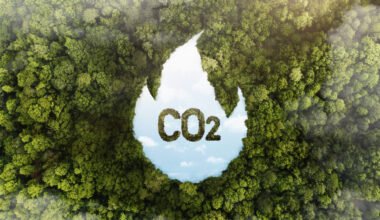
What is Carbon Credit?
In today’s world, where climate change has become a pressing concern, the concept of carbon credit has gained significant attention. But what exactly is carbon credit?
Carbon credit is a market-based approach aimed at reducing greenhouse gas emissions. It is a financial instrument that represents the reduction or removal of one metric ton of carbon dioxide (CO2) or its equivalent greenhouse gases from the atmosphere.
The concept of carbon offsetting
Carbon credit is closely related to the concept of carbon offsetting. Carbon offsetting is the process of compensating for the emissions produced by an individual, organization, or industry by investing in projects that reduce or remove an equivalent amount of greenhouse gases from the atmosphere. These projects can include renewable energy installations, reforestation efforts, or energy efficiency initiatives.
Carbon offsetting allows individuals and organizations to take responsibility for their carbon footprint by supporting projects that contribute to the reduction of greenhouse gas emissions. By purchasing carbon credits, individuals and organizations can effectively offset their emissions and contribute to a greener future.
How does the Carbon Credit system work?
The carbon credit system operates on the principle of cap-and-trade. Governments or regulatory bodies set a limit, or cap, on the total amount of greenhouse gas emissions allowed in a specific period. This cap is divided into individual allowances, which represent the right to emit a certain amount of greenhouse gases. These allowances can be bought and sold in the carbon credit market.
Companies or organizations that emit less than their allocated allowances can sell their surplus allowances as carbon credits to entities that exceed their emission limits. This creates a financial incentive for companies to reduce their emissions and invest in sustainable practices. The carbon credit system effectively rewards companies for their efforts to reduce greenhouse gas emissions and encourages the adoption of environmentally friendly practices.
Benefits of Carbon Credits
The implementation of carbon credits offers several benefits for both the environment and the economy.
Firstly, carbon credits provide a mechanism to reduce greenhouse gas emissions on a large scale. By creating a financial incentive for companies to reduce their emissions, the carbon credit system encourages the adoption of sustainable practices and the development of clean technologies.
Secondly, carbon credits support the growth of renewable energy and other sustainable projects. The revenue generated from the sale of carbon credits can be reinvested in initiatives such as wind farms, solar power plants, and reforestation efforts. This not only contributes to the reduction of greenhouse gas emissions but also promotes the transition to a low-carbon economy.
Furthermore, carbon credits can be seen as a tool for corporate social responsibility. By offsetting their emissions through the purchase of carbon credits, companies can demonstrate their commitment to sustainability and environmental stewardship. This can enhance their reputation and attract environmentally conscious customers, investors, and partners.
Types of Carbon Credits
There are several types of carbon credits available in the market. The most common type is the Certified Emission Reduction (CER), which is generated from projects that have been certified under the Clean Development Mechanism (CDM) of the United Nations Framework Convention on Climate Change (UNFCCC). These projects can include renewable energy installations, energy efficiency initiatives, and methane capture from landfills.
Another type of carbon credit is the Verified Emission Reduction (VER), also known as a voluntary carbon credit. VERs are generated from projects that are not certified under the CDM but still meet certain standards and criteria. These projects can include local community-based initiatives, reforestation efforts, and sustainable agricultural practices.
Carbon Credit projects and initiatives
Carbon credit projects and initiatives play a crucial role in the reduction of greenhouse gas emissions and the promotion of sustainable development. Projects can range from large-scale renewable energy installations to small-scale community-based initiatives. Some examples include wind farms, solar power plants, biomass energy projects, energy-efficient buildings, and afforestation programs.
Additionally, carbon credits can be used to finance projects that provide social and economic co-benefits to local communities. For instance, projects that provide access to clean energy in rural areas, promote sustainable agriculture, or improve waste management practices can contribute to both climate mitigation and sustainable development goals.
Carbon Credit market and trading
The carbon credit market is a global marketplace where carbon credits are bought and sold. It operates based on the principles of supply and demand, with the price of carbon credits fluctuating according to market conditions. The market provides a platform for companies and organizations to trade carbon credits, allowing them to meet their emission reduction targets and comply with regulatory requirements.
Carbon credit trading can take place through different mechanisms, such as bilateral contracts, auctions, and exchanges. Companies can also choose to work with specialized brokers or carbon credit aggregators to facilitate their participation in the market. The transparency and integrity of the market are ensured through the verification and certification of carbon credits by accredited third-party auditors.
Implementing Carbon Credit in businesses and industries
The implementation of carbon credit in businesses and industries requires a comprehensive approach. It involves assessing and quantifying the greenhouse gas emissions associated with operations, setting reduction targets, and implementing strategies to achieve those targets. Companies can then purchase carbon credits to offset their remaining emissions and achieve carbon neutrality.
To effectively implement carbon credit, companies need to invest in sustainable practices and technologies. This can include improving energy efficiency, transitioning to renewable energy sources, optimizing supply chains, and adopting circular economy principles. Companies can also engage in partnerships and collaborations to share best practices and accelerate the adoption of sustainable solutions.
Challenges and criticisms of Carbon Credit
While carbon credit offers a promising solution for mitigating climate change, it is not without challenges and criticisms. One of the main challenges is the accurate measurement and verification of emissions reductions. Calculating the exact amount of greenhouse gas emissions reduced or removed by a project can be complex and uncertain, leading to potential inaccuracies in the carbon credit system.
Another criticism is the potential for carbon offsetting to be used as a substitute for real emission reductions. Some argue that companies may rely too heavily on purchasing carbon credits instead of implementing sustainable practices to reduce their own emissions. This raises concerns about the effectiveness and integrity of the carbon credit system in achieving significant and lasting emission reductions.
Conclusion: Embracing Carbon Credit for a sustainable future
In conclusion, carbon credit represents a sustainable solution for a greener future. By incentivizing the reduction of greenhouse gas emissions and promoting the development of renewable energy and other sustainable projects, carbon credits contribute to global efforts in mitigating climate change. However, it is essential to address the challenges and criticisms associated with carbon credit to ensure its effectiveness and integrity.
To create a truly sustainable future, individuals, businesses, and governments must embrace carbon credit as a tool for reducing emissions and transitioning to a low-carbon economy. By taking responsibility for our carbon footprint and supporting projects that contribute to the reduction of greenhouse gases, we can work together to create a more sustainable and resilient planet for future generations.








